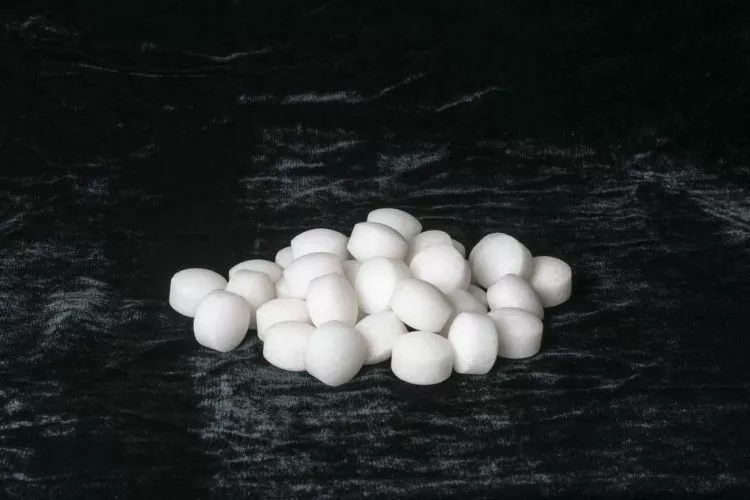Are you troubled by moths invading your space? Knowing how to use mothballs correctly is vital.
Our guide is here to help. We’ll answer the key question – how many mothballs to use in a room?
We will provide a straightforward approach to ensure effective use.

Safety, precautions, and alternatives will also be discussed. Read on to learn how to prevent moth infestations successfully and safely.
How many mothballs to use in a room?
The number of mothballs to use depends on the size of your space. Check the product label for guidance. Most brands suggest two mothballs per cubic feet in a sealed container for textiles.
For larger spaces like a room, the product will not be effective and is unsafe.
Mothballs are insecticides. They can harm humans and pets if used in large, open spaces. High levels of their active ingredients, naphthalene or paradichlorobenzene, can cause health problems. Mothballs are not designed for open spaces or rooms.
These are best for small, sealed spaces to kill moths and larvae. Always follow product instructions. Consider safer alternatives if you need to treat a whole room.
How much exposure to mothballs is toxic?
Mothballs’ toxins are released slowly over time when they are in use. Low-level exposure can cause nausea, headache, dizziness, and eye, nose, and throat irritation.

High levels of exposure, often from prolonged or improper use, can lead to severe health problems such as hemolytic anemia, liver and kidney damage, or even cancer.
The amount needed to be toxic varies based on factors such as the person’s body size, the duration of exposure, and the concentration of the toxins in the air.
Children and pets are especially sensitive. It is crucial to use mothballs only as directed, in sealed containers and away from people and pets.
Safe alternatives are useful. For any concerns about exposure, contact a healthcare provider or poison control center.
What are the symptoms of mothball poisoning in humans?
Mothballs poisoning, or naphthalene poisoning, can cause distinct symptoms in humans. If inhaled, initial symptoms may include a headache, nausea, dizziness, and irritation of the eyes, nose, and throat. Some may also feel confusion or fatigue.
If ingested, it can lead to more severe symptoms. These may start with nausea, vomiting, and abdominal pain. In some cases, diarrhea and fever may follow. One may pass dark, reddish-brown urine due to kidney damage and blood cell destruction.
In severe cases, the person may have increased heart rate, low blood pressure, shivering, yellowing of the skin and eyes, and even seizures. Those severely affected may fall into a coma, which requires immediate medical attention.
Prolonged exposure can lead to liver and kidney damage or cancer. Remember that children and pets are especially at risk. Therefore, always keep mothballs out of their reach. For any concerns, contact a healthcare provider or poison control center.
Can you sleep in the same room with mothballs?
No, sleeping in the same room with mothballs is not safe. Mothballs release fumes which you would inhale throughout the night.
These fumes from naphthalene or paradichlorobenzene, the main ingredients in mothballs, are harmful to humans and pets.

Small amounts can cause headaches, nausea, or eye and lung irritation. Large amounts can lead to serious health problems like kidney and liver damage.
Children and pets are particularly at risk. Proper mothball use is in sealed containers, not open rooms.
Get in touch with a healthcare provider or poison control center if you think you’ve been exposed. If you want to prevent moth infestations, consider safer alternatives.
Where to put mothballs in the house?
Mothballs are best placed in small, closed, and air-tight storage spaces. These include suitcases, trunks, and garment bags.
Ideal items to treat with mothballs include seasonal clothing, fur items, or textiles made of wool. Always ensure the storage vessel is sealed well. This confines the gas and increases effectiveness against moths.

Do not place mothballs in open or semi-open areas. These include wardrobes, bedrooms, living spaces, or any area often accessed by people or pets. This use is not safe and not effective.
Mothballs are not for broad pest control in homes. Safer alternatives exist for comprehensive pest control needs. Always check and follow the instructions on the product label.
frequently asked questions (FAQs)
Can I put mothballs in my bed?
Answer: No, it’s not safe to put mothballs in your bed. Mothballs release harmful vapor which is toxic when inhaled or comes into contact with skin. This can cause irritation, dizziness, headaches, or even more severe health problems.
Can I keep mothballs in the kitchen?
Answer: Mothballs should not be kept in the kitchen. They can contaminate food and cooking surfaces. Also, the fumes can be harmful when inhaled, causing issues such as nausea and eye, nose, and throat irritation.
Is the smell of mothballs harmful to pets?
Answer: Yes, the smell of mothballs is harmful to pets. The chemicals released can cause severe health issues in animals if inhaled or ingested. Symptoms include vomiting, seizures, or even life-threatening anemia.
Is it illegal to put mothballs around your house?
Answer: While specific laws vary, using mothballs improperly can be illegal. This includes scattering them around your house or yard. They should only be used in air-tight containers for clothing storage.
How long does it take for mothballs to stop smelling?
Answer: Mothballs can take several weeks to several months to fully evaporate and stop releasing odors. This depends on factors such as the number of mothballs and ventilation in the space.
Is there an alternative to mothballs?
Answer: Yes, there are many alternatives to mothballs. These include cedar chips, lavender sachets, airtight storage, and professional pest control services. These options can protect your belongings without the health risks of mothballs.
Conclusion:
Using mothballs in a room is not safe or recommended. They should only be used in sealed containers for specific items, such as clothing or fabrics.
To keep your home moth-free, opt for safer alternatives like cedar chips, lavender sachets, or professional pest control. By choosing non-toxic options, you can protect your belongings while ensuring the health and safety of your family and pets.


